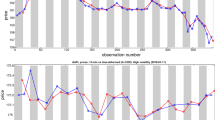Abstract
Level shifts confound the estimation of persistence. This paper shows analytically, in simulations, and using high-frequency stock price data that models for financial volatility that feature a separate source of randomness in the volatility equation are less susceptible to this effect. Such models include recently proposed time series models for realized volatility, as opposed to GARCH models for daily observations, which are highly sensitive to unknown shifts, as has been shown before.
Similar content being viewed by others
References
Andersen T., Bollerslev T., Diebold F.X.: Roughing it up: including jump components in the measurement, modeling and forecasting of return volatility. Rev Econ Stat 89(4), 701–720 (2007)
Andreou E., Ghysels E.: Detecting multiple breaks in financial market volatility dynamics. J Appl Economet 17, 579–600 (2002)
Bai J.: Least quares estimation of a shift in linear processes. J Time Ser Anal 15(5), 453–472 (1994)
Bai J.: Estimating multiple breaks one at a time. Economet Theory 13, 315–352 (1997)
Bai J., Perron P.: Estimating and testing linear models with multiple structural changes. Econometrica 66(1), 47–78 (1998)
Barndorff-Nielsen O.E., Hansen P.R., Lunde A., Shephard N.: Designing realised kernels to measure the ex-post variation of equity prices in the presence of noise. Econometrica 76, 1481–1536 (2008)
Berkes I., Gombay E., Horvath L., Kokoszka P.: Sequential change-point detection in GARCH(p,q) models. Economet Theory 20, 1140–1167 (2004)
Bollerslev T.: Generalized autoregressive conditional heteroskedasticity. J Economet 31, 307–327 (1986)
Chen C., Tiao G.C.: Random level-shift time series models, ARIMA approximations, and level-shift detection. J Bus Econ Stat 8(1), 83–97 (1990)
Choi K., Zivot E.: Long memory and structural changes in the forward discount: an mpirical investigation. J Int Money Finance 26(3), 342–362 (2007)
Corsi F.: A simple approximate long memory model of realized volatility. J Financ Economet 7(2), 174–196 (2009)
Davidson J., Sibbertsen P.: Generating schemes for long memory processes: regimes, aggregation and linearity. J Economet 128, 253–282 (2005)
Diebold F.X.: Modeling the persistence of conditional variances: a comment. Economet Rev 5, 51–56 (1986)
Diebold F.X., Inoue A.: Long memory and regime switching. J Economet 105, 131–159 (2001)
Engle R.F.: Autoregressive conditional heteroscedasticity with estimates of the variance of United Kingdom inflation. Econometrica 50(4), 987–1007 (1982)
Engle R.F., Bollerslev T.: Modeling the persistence of conditional variances. Economet Rev 5, 1–50 (1986)
Fouque J.P., Papanicolaou G., Sircar K.R., Sølna K.: Short time-scale in S&P 500 volatility. J Comput Finance 6, 1–23 (2003)
Francq C., Roussignol M., Zakoïan J.M.: Conditional heteroskedasticity driven by hidden Markov chains. J Time Ser Anal 22, 197–220 (2001)
Frühwirth-Schnatter S.: Full Bayesian analysis of switching Gaussian state space models. Ann Inst Stat Math 53(1), 31–49 (2001)
Granger C.W.J., Hyung N.: Occasional structural breaks and long memory with an application to the S&P500 absolute stock returns. J Empir Finance 3, 399–421 (2004)
Granger C.W.J., Teräsvirta T.: A simple nonlinear time series model with misleading linear properties. Econ Lett 62, 161–165 (2001)
Gray S.: Modeling the conditional distribution of interest rates as a regime-switching process. J Financ Econ 42, 27–62 (1996)
Hamilton J.D.: A new approach to the economic analysis of nonstationary time series and the business cycle. Econometrica 57(2), 357–384 (1989)
Hamilton J.D., Susmel R.: Autoregressive conditional heteroskedasticity and changes in regime. J Economet 64, 307–333 (1994)
Han H., Park J.Y.: Time series properties of ARCH processes with persistent covariates. J Economet 146, 275–292 (2008)
Hendry D.F., Neale A.J.: A Monte Carlo study of the effects of structural breaks on tests for unit roots. In: Hackl, P., Westlund, A.H. (eds) Economic Structural Change, Analysis and Forecasting, pp. 95–119. Springer, New York (1991)
Hillebrand E.: Neglecting parameter changes in GARCH models. J Economet 129, 121–138 (2005)
Hillebrand E., Medeiros M.C.: Estimating and forecasting GARCH models in the presence of structural breaks and regime switches. In: Rapach, D.E., Wohar, M. (eds) Forecasting in the Presence of Structural Breaks and Model Uncertainty, pp. 303–325. Elsevier, Emerald (2008)
Hyung N., Poon S.H., Granger C.W.J.: A source of long memory in volatility. In: Rapach, D.E., Wohar, M. (eds) Forecasting in the Presence of Structural Breaks and Model Uncertainty, pp. 329–380. Elsevier, Emerald (2008)
Kaufmann S., Frühwirth-Schnatter S.: Bayesian analysis of switching ARCH models. J Time Ser Anal 23(4), 425–458 (2002)
Kokoszka P., Leipus R.: Testing for parameter changes in ARCH models. Lithuanian Math J 39(2), 182–195 (1999)
Kokoszka P., Leipus R.: Changepoint estimation in ARCH models. Bernoulli 6, 513–539 (2000)
Lamoureux C.G., Lastrapes W.D.: Persistence in variance, structural change, and the GARCH model. J Bus Econ Stat 8, 225–234 (1990)
Lobato I.N., Savin N.E.: Real and spurious long-memory properties of stock-market data. J Bus Econ Stat 16, 261–268 (1998)
Lumsdaine R.: Consistency and asymptotic normality of the quasi-maximum likelihood estimator in IGARCH(1,1) and covariance stationary GARCH(1,1) models. Econometrica 64, 575–596 (1996)
Medeiros M.C., Veiga A.: Modeling multiple regimes in financial volatility with a flexible coefficient GARCH(1,1) model. Economet Theory 25, 117–161 (2009)
Mikosch T., Starica C.: Nonstationarities in financial time series, the long-range dependence, and the IGARCH effects. Rev Econ Stat 86, 378–390 (2004)
Ng S., Vogelsang T.J.: Analysis of vector autoregressions in the presence of shifts in mean. Economet Rev 21(3), 353–381 (2002)
Perron P.: The great crash, the oil price shock, and the unit root hypothesis. Econometrica 57(6), 1361–1401 (1989)
Perron P.: Testing for a unit root in a time series with a changing mean. J Bus Econ Stat 8(2), 153–162 (1990)
Rapach D.E., Strauss J.K.: Structural breaks and GARCH models of exchange rate volatility. J Appl Economet 23(1), 65–90 (2008)
Rapach D.E., Strauss J.K., Wohar M.: Forecasting stock return volatility in the presence of structural breaks. In: Rapach, D.E., Wohar, M. (eds) Forecasting in the Presence of Structural Breaks and Model Uncertainty, pp. 81–416. Elsevier, Emerald (2008)
Smith A.: Level shifts and the illusion of long memory in economic time series. J Bus Econ Stat 23(3), 321–335 (2005)
Author information
Authors and Affiliations
Corresponding author
Rights and permissions
About this article
Cite this article
Craioveanu, M., Hillebrand, E. Level changes in volatility models. Ann Finance 8, 277–308 (2012). https://doi.org/10.1007/s10436-010-0163-5
Received:
Accepted:
Published:
Issue Date:
DOI: https://doi.org/10.1007/s10436-010-0163-5




